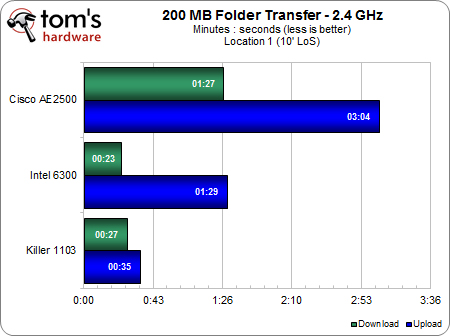Killer Wireless-N 1103 Review: Can Qualcomm Take On Centrino?
Benchmark Results: 2.4 GHz Transfer Tests
Let’s start with examining our 2 GB single-file transfer tests.
If there were any doubts that up- and down-stream performance are two very different beasts, these first charts should lay such ambiguities to rest.
We see the expected fall-off from the USB adapter as distance and obstructions increased, but we were surprised to see how close Intel and Qualcomm were on download speeds. Given a reasonable margin of error, we’d call them essentially identical. However, Qualcomm shows its mettle on uploads, demonstrating a roughly 200% advantage over the Intel 6300. That said, neither company is able to conquer the ambient RF conditions and sustain an upload from our third location. At best, there would be a few minutes of transfer before the connection cut off.
We ran across two small mysteries here. First, several download tests performed slower in Location 1 than Location 2, which appears backwards. But we confirmed the results in repeated tests. The upload tests in these sets presented results that fell in line with expectations. Second, if you figure about 25 seconds for the Intel or Qualcomm parts to download 200 MB of small files, that’s roughly 8 MB/s. If you figure 3 minutes 40 seconds as a ballpark for the 2 GB download, that’s just over 9 MB/s. Honestly, we expected to see more overhead impact on all of those small file transfers. Either way, hitting in the 60 to 70 Mb/s range for file copying is respectable for integrated Wi-Fi.
Again, we see uploads fail from Location 3, and our USB adapter barely clings to life on these 2.4 GHz distance downloads. Now let’s look at the performance when we switch to 5.0 GHz.
Get Tom's Hardware's best news and in-depth reviews, straight to your inbox.
Current page: Benchmark Results: 2.4 GHz Transfer Tests
Prev Page What And How We Tested Next Page Benchmark Results: 5.0 GHz Transfer Tests-
phamhlam I wish they would build better PCI-Express WiFi Adapter. Some of us can't have a cable going through our house or have our computer sit next to the router.Reply -
KelvinTy I think if you have the lowest latency at your end and leave everything on the server and internet end. Then it would be a lot better, especially there is input lag from everything, monitor, mouse, keyboard, wireless card, router and internet...Reply -
reghir There are 2 versions of the E4200 did you use version 1 or 2 as version 2 increases to 450Mbps on both bands and full spatial on its 3X3 streams?Reply -
MKBL I hope TH will review on powerline Ethernet adapter against typical RJ45 and wifi. For the same reason as phalmhlam, my desktop is connected to router by a long cable running across floor, which bothers me and my family sometimes. I've been considering powerline ethernet, but I can't make decision between that and wireless-N, because I have no idea which one has better performance/price.Reply -
CaedenV Great article! I learned quite a few things from it.Reply
I still think I will be waiting for 802.11ac before upgrading from G though. -
jaylimo84 M. Van Winkle,Reply
Thanks for this nice article.
I own an Alienware M17xR3, with the Killer 1103.
Upon installation, the driver was causing me issues (nothing big tho), and I decided to follow a forum recommendation and install the Atheros Osprey driver instead of Killer's.
It seems the two card are identical apart from the name on it. (Maybe I am misleaded)
It could be interesting to see if the Killer 1103 gets any improvement using the Killer driver vs. the vanilla Atheros drivers, and see if "years of working with the windows tcp stack" pays off. Or if your performance improvement is due to a good, but still normal card. -
CaedenV MKBLI hope TH will review on powerline Ethernet adapter against typical RJ45 and wifi. For the same reason as phalmhlam, my desktop is connected to router by a long cable running across floor, which bothers me and my family sometimes. I've been considering powerline ethernet, but I can't make decision between that and wireless-N, because I have no idea which one has better performance/price.Indeed, it is an issue. I ended up wiring the house through the HVAC ducts, which is a terrible idea (breaks all sorts of building codes), but better than drilling holes all throughout the house only to move to wireless within the next 5-10 years.Reply -
XmortisX I would like to try this out. If they can make a good pci-e/pci version of this card then definitely would try to push it with my clients. Even though we may get more labor hours for running wires the convenience and idea of avoiding HVAC ducts building codes makes this appealing.Reply





